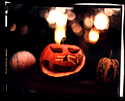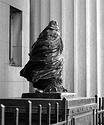richard littlewood
Member
I often make 30x40's, and use a single tray. I find it easy. Dev, stop and fix are each in their own buckets on the floor, and I pour over the dev, agitate like mad (usually 5l of fluid) and this is no problem with a 3min dev, on nearly 3 mins get hold of the tray and pour the dev back into it's bucket, then relax a bit when the stop is poured in. Same thing, stop back in the bucket then pour over the fix. Sometimes I'll move the tray under the tap for a water rinse at some point.
Never had a problem with streaks, I like watching the print as it develops, and after the fix has gone, I can rinse the print with as many changes of water as I want, turning it over to make sure all the sticky fix is washed off. The real wash comes later, and the print goes into another big 'holding' dish while I do another.
Only drawback in doing this is it's a pretty physical thing, but another advantage is that toning can be done the same way.
Never had a problem with streaks, I like watching the print as it develops, and after the fix has gone, I can rinse the print with as many changes of water as I want, turning it over to make sure all the sticky fix is washed off. The real wash comes later, and the print goes into another big 'holding' dish while I do another.
Only drawback in doing this is it's a pretty physical thing, but another advantage is that toning can be done the same way.






 ). I am proud of the joining lines as they clearly differentiate my work from "stitched" work. However, I have been doing this for 5 years and still don't feel like I have a good technique to glue them together. Currently I am using tape to hold the images together and then using super glue for the bond. The reason I have been using that technique is that superglue glue flows well and leaches under the two pieces of paper while they are still held in alignment. Then it sets instantly.
). I am proud of the joining lines as they clearly differentiate my work from "stitched" work. However, I have been doing this for 5 years and still don't feel like I have a good technique to glue them together. Currently I am using tape to hold the images together and then using super glue for the bond. The reason I have been using that technique is that superglue glue flows well and leaches under the two pieces of paper while they are still held in alignment. Then it sets instantly.
